Hervey Bay/Fraser Island (for Feb. 22)
Today we did a one day Fraser Island tour. It is one of those “must do” when visiting Australia activities. This island is the largest sand island in the world at 123 km long and 23 km wide and is a World Heritage Site.
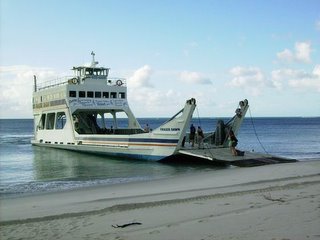 The tour bus picked us up outside our hotel at 8, made a few more stops, and took us to the ferry. We arrived on the island an hour later at 9:30 and boarded a special 4WD bus.
The tour bus picked us up outside our hotel at 8, made a few more stops, and took us to the ferry. We arrived on the island an hour later at 9:30 and boarded a special 4WD bus. 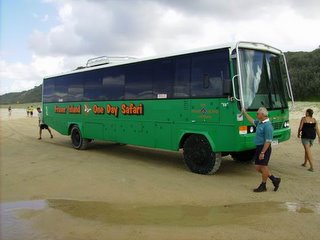 Off we went on roads barely wider than the bus in sand almost as fine as talcum powder with deep ruts in many places. We landed on the western shore and had to cross the island for many of our activities.
Off we went on roads barely wider than the bus in sand almost as fine as talcum powder with deep ruts in many places. We landed on the western shore and had to cross the island for many of our activities.
The first stop was in a section of rainforest where the driver kicked us out and made us walk for a km. Along the way, some of the major tree species (which the driver had previously pointed out) were labeled for our closer examination and we soaked up the atmosphere of being in a rainforest. I am going to go into a little detail about it for posterity, so, if you are not interested in trees, you can skip ahead.
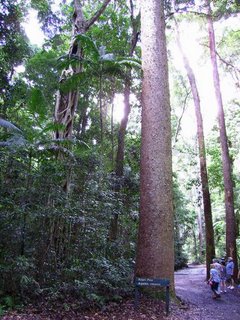 One of the prized species of past generations was the Kauri Pine, which was prized for masts for sailing ships because it grew so tall and straight. We had previously heard about this tree in New Zealand where Kauri were harvested almost to extinction.
One of the prized species of past generations was the Kauri Pine, which was prized for masts for sailing ships because it grew so tall and straight. We had previously heard about this tree in New Zealand where Kauri were harvested almost to extinction.
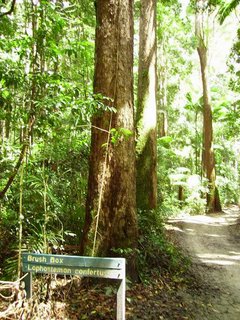 A common species is the Brush Box, which apparently is used to produce beautiful flooring.
A common species is the Brush Box, which apparently is used to produce beautiful flooring.
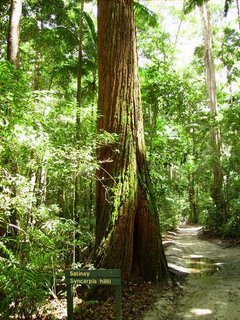 Satinay belongs to the turpentine family (I didn’t know there was one.). It is very useful in building piers and jetties as it is very resistant to salt water and sea creatures don’t like to eat it. It has very rough bark with deep grooves.
Satinay belongs to the turpentine family (I didn’t know there was one.). It is very useful in building piers and jetties as it is very resistant to salt water and sea creatures don’t like to eat it. It has very rough bark with deep grooves.
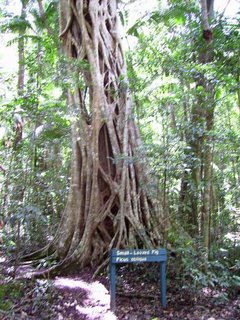 But the most interesting is the Single-leaved Fig, a parasite that preys particularly on the Brush Box. Our driver called it the Strangling Fig. It begins life as a seed deposited in the upper branches of another tree by a bird. If conditions are right, it sprouts and sends a runner to the ground. It takes root there, but also attaches itself to the host tree. Eventually it kills the host, which rots away, leaving a hollow column of fig, which has now established its own root system in the ground.
But the most interesting is the Single-leaved Fig, a parasite that preys particularly on the Brush Box. Our driver called it the Strangling Fig. It begins life as a seed deposited in the upper branches of another tree by a bird. If conditions are right, it sprouts and sends a runner to the ground. It takes root there, but also attaches itself to the host tree. Eventually it kills the host, which rots away, leaving a hollow column of fig, which has now established its own root system in the ground.
Now, on to more interesting stuff. I hope! Our next destination was a resort where we were to have lunch. Only 400 metres from our goal, we were halted by a broken down private 4WD. (These are allowed if they pay the fees and stick to the roads and beach.) The accelerator was stuck in the full open position. It was impossible to get around him to give him a tow. Fortunately, our driver had radio communication and was able to radio the resort to send out a truck to tow him in ahead of us. Within about 15 minutes we were back underway and soon we were dining on a nice buffet lunch.
 From lunch we headed out onto the beach on the east coast of the island. First stop was the rusting hulk of the Maheno. It was built as a 400 foot long luxury liner about 1905 and used as a cruise ship in Australian waters. (It even cruised to Vancouver a couple of times.) In 1935 it was being towed to Europe as scrap when the tow line broke in a storm and it washed ashore here. It is now half buried in sand. It is amazing how the sea has eaten away the exposed steel over the decades. It is all rotten.
From lunch we headed out onto the beach on the east coast of the island. First stop was the rusting hulk of the Maheno. It was built as a 400 foot long luxury liner about 1905 and used as a cruise ship in Australian waters. (It even cruised to Vancouver a couple of times.) In 1935 it was being towed to Europe as scrap when the tow line broke in a storm and it washed ashore here. It is now half buried in sand. It is amazing how the sea has eaten away the exposed steel over the decades. It is all rotten.
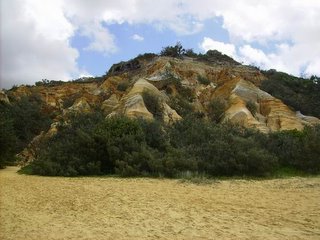
Next stop was The Pinnacles, a cliff of compacted, coloured sand (not sandstone).
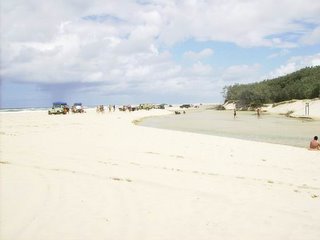 Our last stop on the east coast was at Eli Creek, one of many creeks where the fresh water from the island’s interior makes its way back to the sea. After being filtered by all that sand, it is crystal clear. It is a very popular place to cool off for everyone passing by. They also have a boardwalk along the creek for 100 metres or so into the bush.
Our last stop on the east coast was at Eli Creek, one of many creeks where the fresh water from the island’s interior makes its way back to the sea. After being filtered by all that sand, it is crystal clear. It is a very popular place to cool off for everyone passing by. They also have a boardwalk along the creek for 100 metres or so into the bush.
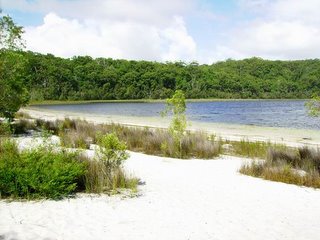
From the creek we returned to the resort to pick up a road to an interior lake, Lake Garawongera. (How do you get lakes in sand, you ask? Well, over time, the litter from tree bark and leaves accumulates in hollows and forms enough peat that it slows the seeping through the sand.) It was OK, but a bit if a disappointment compared to what we had come to expect. It was quite small and shallow with a mostly weedy bottom and a lot of grass on the beach. It was very warm though. Our driver speculated that it would be around 26 degrees. A rain shower passed by as we were getting into the water and, after the cold rain and a bit of a breeze, submerging in the lake was like getting into a bathtub.
On the way back to the ferry, our path was blocked by a fallen tree. It was a straight trunk about 50 feet long varying from about a 6 inch diameter at the bottom to a 3 inch diameter at the top and topped by a few branches. The driver, two other guys, and I tried to slide it out of our way to one side, but it was jammed between other trees and we could only move it part of the way. The driver retreated to the bus and returned with an axe. With about 6 chops he cut through a 4 inch diameter section and we were on our way. Either that wood is pretty soft or he is a heck of a woodsman. He was a pretty interesting guy. He spent much of his youth on the island and you could tell he really loved the place. He was filled with stories of its history and knowledge of its flora and fauna.
We were back at the ferry at 5, back on the mainland by 6 and back at our hotel at 6:30.
 The tour bus picked us up outside our hotel at 8, made a few more stops, and took us to the ferry. We arrived on the island an hour later at 9:30 and boarded a special 4WD bus.
The tour bus picked us up outside our hotel at 8, made a few more stops, and took us to the ferry. We arrived on the island an hour later at 9:30 and boarded a special 4WD bus.  Off we went on roads barely wider than the bus in sand almost as fine as talcum powder with deep ruts in many places. We landed on the western shore and had to cross the island for many of our activities.
Off we went on roads barely wider than the bus in sand almost as fine as talcum powder with deep ruts in many places. We landed on the western shore and had to cross the island for many of our activities.The first stop was in a section of rainforest where the driver kicked us out and made us walk for a km. Along the way, some of the major tree species (which the driver had previously pointed out) were labeled for our closer examination and we soaked up the atmosphere of being in a rainforest. I am going to go into a little detail about it for posterity, so, if you are not interested in trees, you can skip ahead.
 One of the prized species of past generations was the Kauri Pine, which was prized for masts for sailing ships because it grew so tall and straight. We had previously heard about this tree in New Zealand where Kauri were harvested almost to extinction.
One of the prized species of past generations was the Kauri Pine, which was prized for masts for sailing ships because it grew so tall and straight. We had previously heard about this tree in New Zealand where Kauri were harvested almost to extinction. A common species is the Brush Box, which apparently is used to produce beautiful flooring.
A common species is the Brush Box, which apparently is used to produce beautiful flooring. Satinay belongs to the turpentine family (I didn’t know there was one.). It is very useful in building piers and jetties as it is very resistant to salt water and sea creatures don’t like to eat it. It has very rough bark with deep grooves.
Satinay belongs to the turpentine family (I didn’t know there was one.). It is very useful in building piers and jetties as it is very resistant to salt water and sea creatures don’t like to eat it. It has very rough bark with deep grooves. But the most interesting is the Single-leaved Fig, a parasite that preys particularly on the Brush Box. Our driver called it the Strangling Fig. It begins life as a seed deposited in the upper branches of another tree by a bird. If conditions are right, it sprouts and sends a runner to the ground. It takes root there, but also attaches itself to the host tree. Eventually it kills the host, which rots away, leaving a hollow column of fig, which has now established its own root system in the ground.
But the most interesting is the Single-leaved Fig, a parasite that preys particularly on the Brush Box. Our driver called it the Strangling Fig. It begins life as a seed deposited in the upper branches of another tree by a bird. If conditions are right, it sprouts and sends a runner to the ground. It takes root there, but also attaches itself to the host tree. Eventually it kills the host, which rots away, leaving a hollow column of fig, which has now established its own root system in the ground.Now, on to more interesting stuff. I hope! Our next destination was a resort where we were to have lunch. Only 400 metres from our goal, we were halted by a broken down private 4WD. (These are allowed if they pay the fees and stick to the roads and beach.) The accelerator was stuck in the full open position. It was impossible to get around him to give him a tow. Fortunately, our driver had radio communication and was able to radio the resort to send out a truck to tow him in ahead of us. Within about 15 minutes we were back underway and soon we were dining on a nice buffet lunch.
 From lunch we headed out onto the beach on the east coast of the island. First stop was the rusting hulk of the Maheno. It was built as a 400 foot long luxury liner about 1905 and used as a cruise ship in Australian waters. (It even cruised to Vancouver a couple of times.) In 1935 it was being towed to Europe as scrap when the tow line broke in a storm and it washed ashore here. It is now half buried in sand. It is amazing how the sea has eaten away the exposed steel over the decades. It is all rotten.
From lunch we headed out onto the beach on the east coast of the island. First stop was the rusting hulk of the Maheno. It was built as a 400 foot long luxury liner about 1905 and used as a cruise ship in Australian waters. (It even cruised to Vancouver a couple of times.) In 1935 it was being towed to Europe as scrap when the tow line broke in a storm and it washed ashore here. It is now half buried in sand. It is amazing how the sea has eaten away the exposed steel over the decades. It is all rotten.
Next stop was The Pinnacles, a cliff of compacted, coloured sand (not sandstone).
 Our last stop on the east coast was at Eli Creek, one of many creeks where the fresh water from the island’s interior makes its way back to the sea. After being filtered by all that sand, it is crystal clear. It is a very popular place to cool off for everyone passing by. They also have a boardwalk along the creek for 100 metres or so into the bush.
Our last stop on the east coast was at Eli Creek, one of many creeks where the fresh water from the island’s interior makes its way back to the sea. After being filtered by all that sand, it is crystal clear. It is a very popular place to cool off for everyone passing by. They also have a boardwalk along the creek for 100 metres or so into the bush.
From the creek we returned to the resort to pick up a road to an interior lake, Lake Garawongera. (How do you get lakes in sand, you ask? Well, over time, the litter from tree bark and leaves accumulates in hollows and forms enough peat that it slows the seeping through the sand.) It was OK, but a bit if a disappointment compared to what we had come to expect. It was quite small and shallow with a mostly weedy bottom and a lot of grass on the beach. It was very warm though. Our driver speculated that it would be around 26 degrees. A rain shower passed by as we were getting into the water and, after the cold rain and a bit of a breeze, submerging in the lake was like getting into a bathtub.
On the way back to the ferry, our path was blocked by a fallen tree. It was a straight trunk about 50 feet long varying from about a 6 inch diameter at the bottom to a 3 inch diameter at the top and topped by a few branches. The driver, two other guys, and I tried to slide it out of our way to one side, but it was jammed between other trees and we could only move it part of the way. The driver retreated to the bus and returned with an axe. With about 6 chops he cut through a 4 inch diameter section and we were on our way. Either that wood is pretty soft or he is a heck of a woodsman. He was a pretty interesting guy. He spent much of his youth on the island and you could tell he really loved the place. He was filled with stories of its history and knowledge of its flora and fauna.
We were back at the ferry at 5, back on the mainland by 6 and back at our hotel at 6:30.

0 Comments:
Post a Comment
<< Home